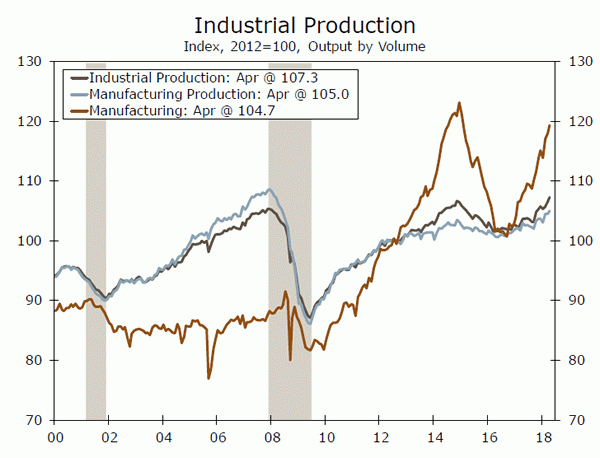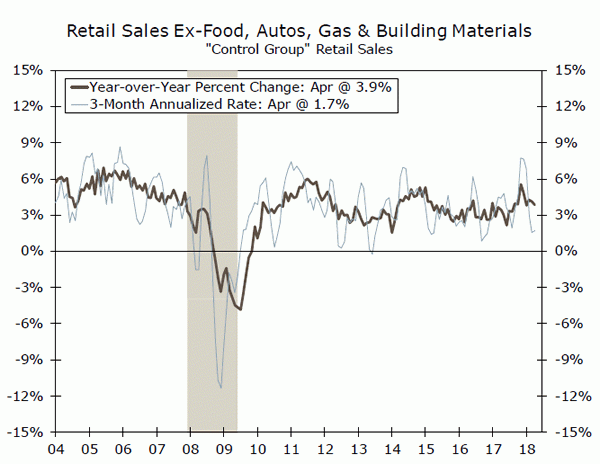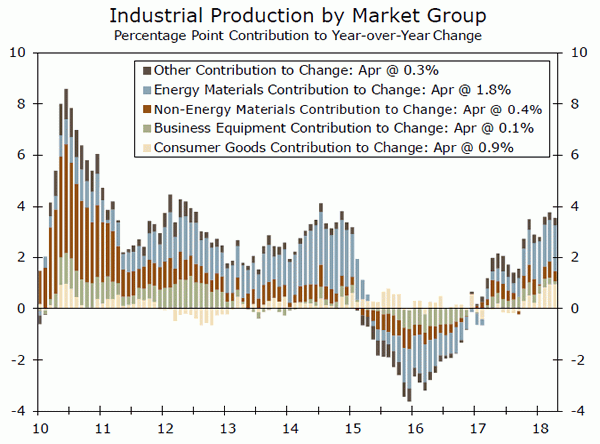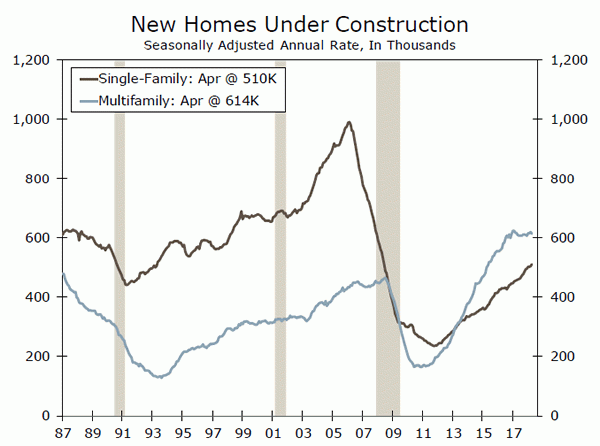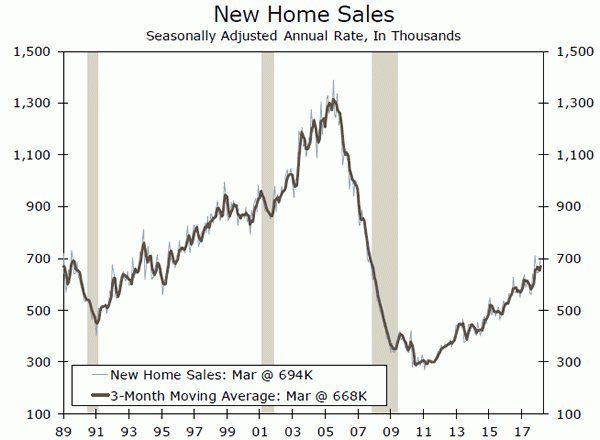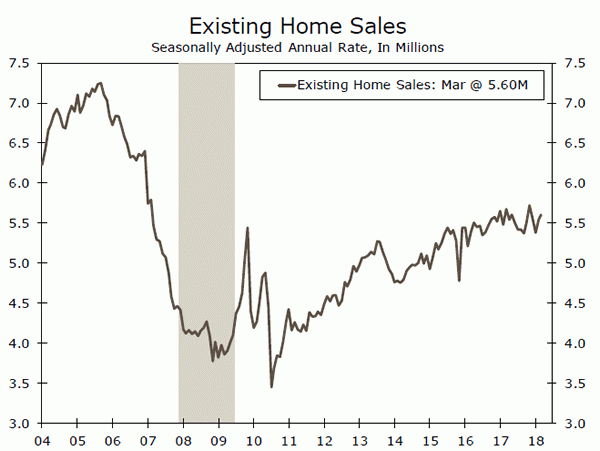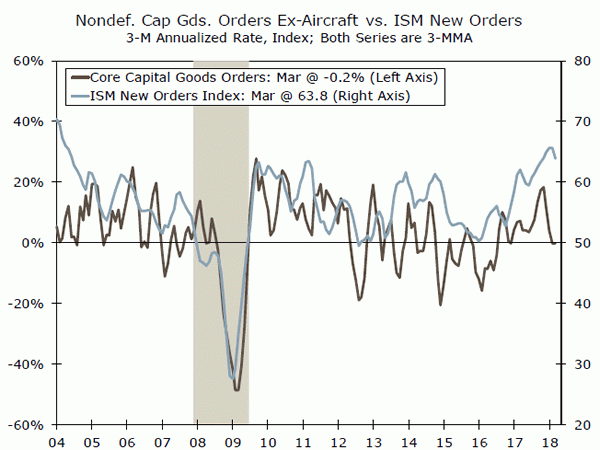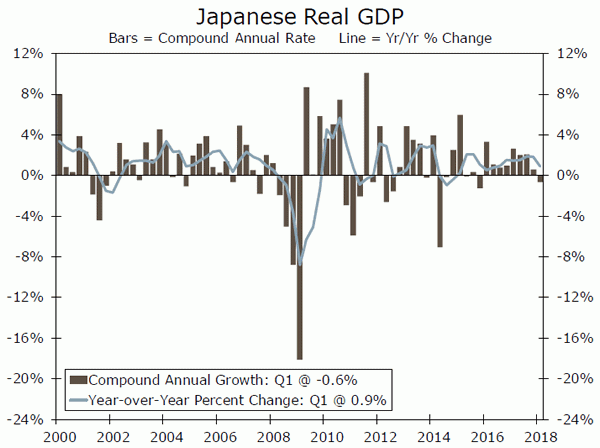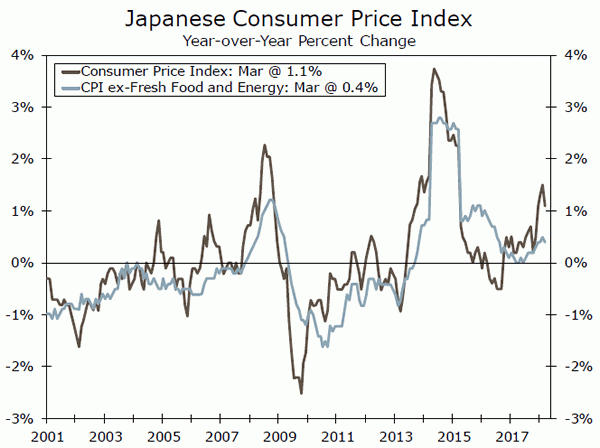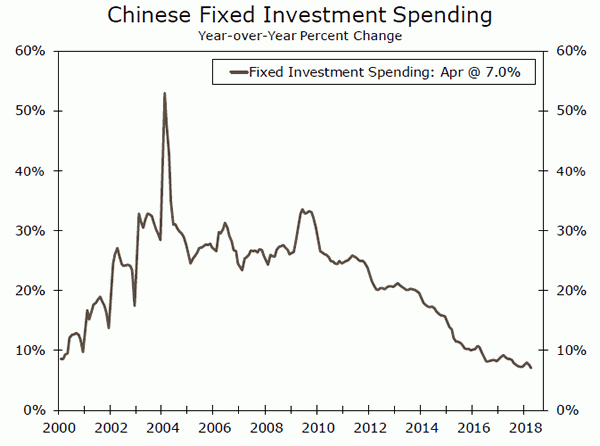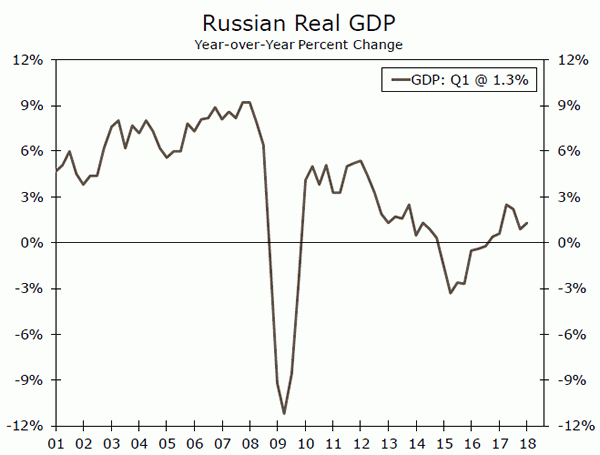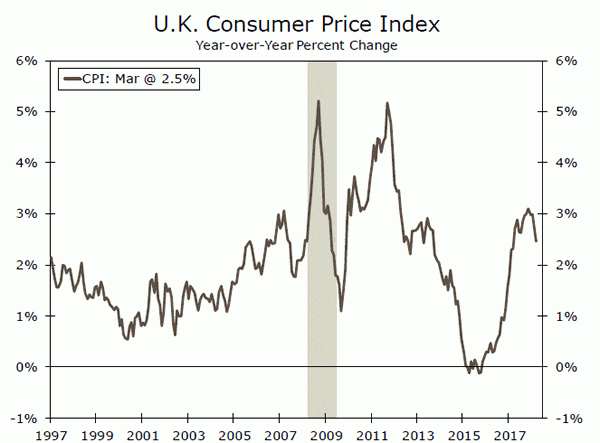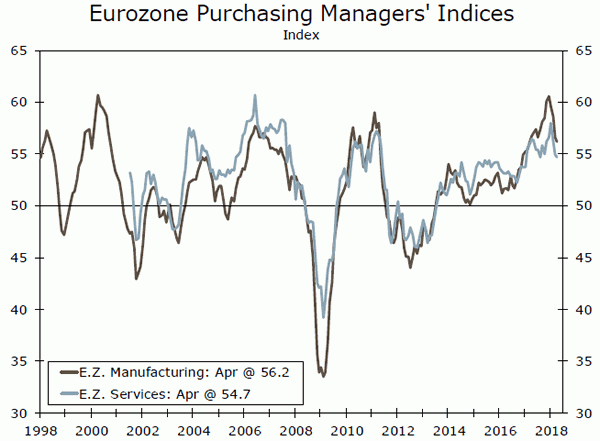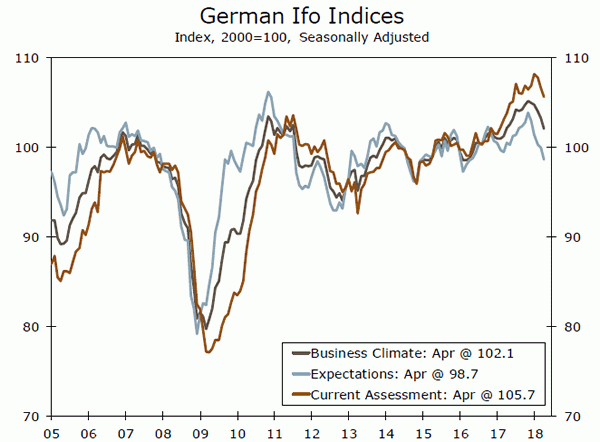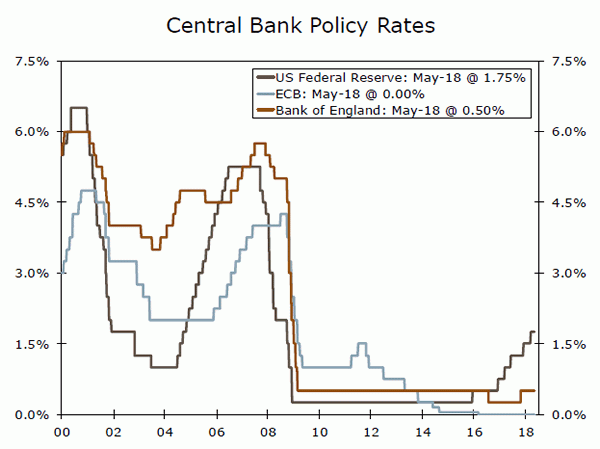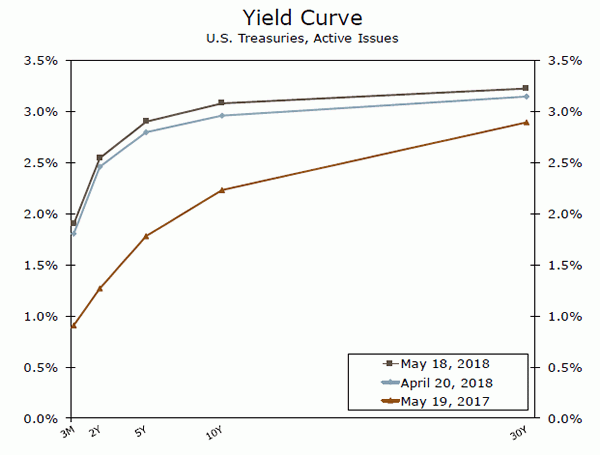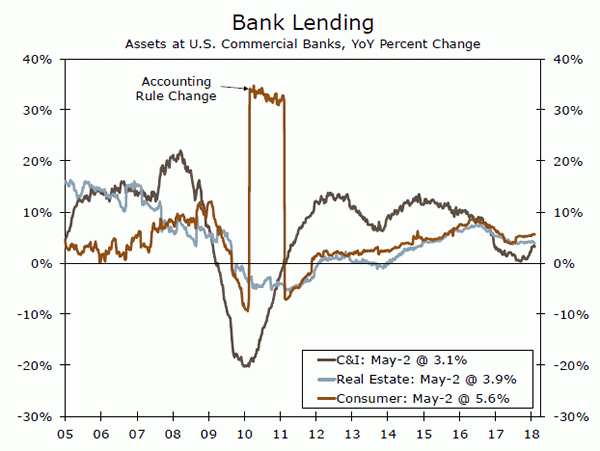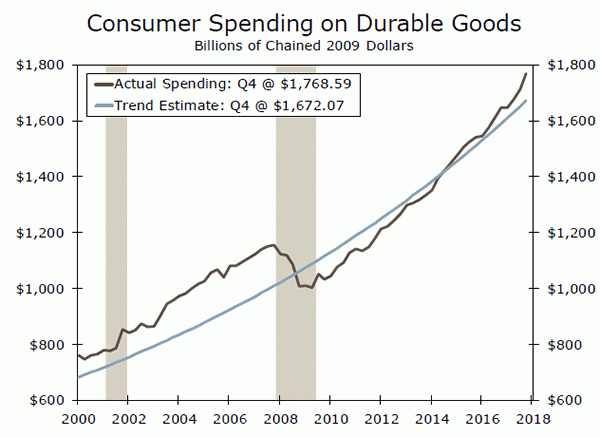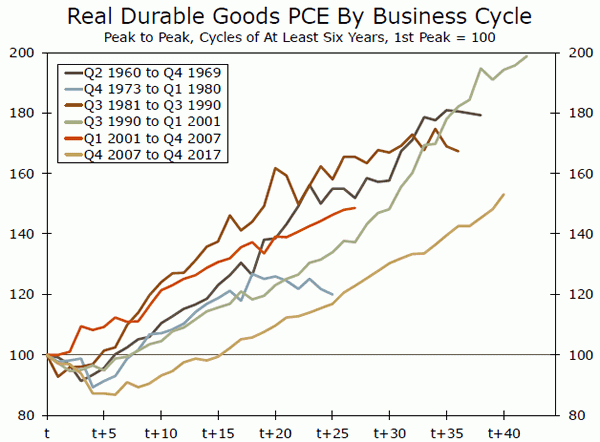U.S. Review
Modestly Positive Data on the Domestic Front
- This past week several key economic indicators hit the wire, taking a pulse for several important sectors. While the headline figures did not jump off the pages, the details are more encouraging.
- Retail sales rebounded in April, with notable strength in control group sales, the component that feeds into GDP. Industrial production reached a series high, with contributions from all industry groups. Housing starts contracted on the month, however builder optimism remains relatively high.
- Continued strength in the domestic data flows adds further support for three more rate hikes in 2018.
Domestic Data Supports Further Fed Hikes
It was a fairly busy week on the domestic data front with the release of several notable indicators representing major sectors of the economy. Retail sales increased 0.3 percent in April, while March sales were revised upward, an indication that strength has returned to the consumer sector after several months of negative or weak prints. The retail sales control group, which is used to calculate GDP, was relatively strong in April and revised higher in March, which suggests that economic activity strengthened at the end of Q1 and is on solid footing to begin Q2. The strongest sectors of retail in April were clothing stores and gasoline stations, mostly driven by the recent increase in gasoline prices. Food services & drinking places and health & personal care stores were the notable weak spots, contracting 0.3 percent and 0.4 percent on the month, respectively. Year over year, non-store retailers, which is an alternative expression for e-commerce, is up an impressive 9.6 percent. While we expect the growth in e-commerce to moderate slightly, the growth numbers will likely remain comparatively robust.
In the world of real estate, housing starts fell 3.7 percent in April, with multi-family projects accounting for all the drop. While the headline figure is not very encouraging, builders appear to be quite optimistic. The Wells Fargo/National Association of Homebuilders Index rose to 70 in May and has been at this level or higher for most of the year. Demand for new homes remains strong across nearly all price points in most major markets. A major factor holding back housing starts has been the recent volatility in apartment construction. We still believe there is life in the apartment boom, with renewed building in supply-constrained markets like Los Angeles and Denver. We also suspect that the supply of new homes and apartments will increase in the coming months. The number of single-family homes under construction rose 1.0 percent in April and continues to trend higher.
Moreover, industrial production reached a new high in April, with contributions from all three industry groups. The renewed strength in the index has been supported by the rebound in energy prices. Mining output increased 1.1 percent in April, marking the third straight monthly gain for this category. Not surprisingly, the mining sector is the closest to experiencing capacity constraints, as it is at 90.6 percent utilization. Contributing to April’s strength was the utilities component of the index. It was the 13th coldest April on record in the U.S., a month when the heat is still running in most places. Natural gas output shot up 10.3 percent month over month, and was up a significant 32.3 percent from April of 2017.
Furthermore, the Leading Economic Index, which is a bellwether for short-term economic growth, increased 0.4 percent in April. The index was supported by broad-based component strength, with notable resilience in the components related to the labor market. The soft and hard data continue to support one another, a signal of stable and balanced growth. The April print adds further evidence that economic growth will continue through 2018, and suggests the Fed will continue to administer rate hikes in 2018 and 2019.
U.S. Outlook
New Home Sales • Wednesday
New home sales increased an above-consensus 4.0 percent in March, rising to a 694,000-unit pace. This strong print follows an upwardlyrevised 3.6 percent gain in February, and January also saw upward revisions. These upward revisions have brought new home sales to a level more consistent with the lofty levels of homebuilder confidence behind surging prices and eager demand. Western markets have seen the strongest rise in new home sales, jumping 28.3 percent in March. Much of this is driven from the migration to markets with relative affordability in inland California, Las Vegas and Phoenix.
We expect new home sales to continue climbing as demand remains strong and inventories remain thin behind increased input costs and shortages of labor and lots. The migration to affordable markets with less land restrictions will likely be where we will see the strongest growth.
Previous: 694K Wells Fargo: 679K Consensus: 678K
Existing Home Sales • Thursday
Existing home sales rose modestly in March, climbing 1.1 percent to a 5.60-million unit pace. The existing home-buying market is extremely competitive, as half of homes sold in the month were on the market for less than a month due to tight inventory. In addition, the median price of resale homes was 5.8 percent higher than it was a year ago. Sales were strongest in the Northeast and Midwest in March, largely due to payback and volatility from winter weather. Sales in these regions still trail their year-ago pace.
The number of available homes for sale is 7.2 percent lower than a year ago, and this figure has dropped for 34 consecutive months. Demand is keeping inventories low as job and income growth, as well as demographic factors, remain supportive of homeownership. We expect new home sales growth to rise modestly as demand is strong, but to be capped by rising prices that are limiting affordable options for first-time buyers.
Previous: 5.60M Wells Fargo: 5.64M Consensus: 5.56M
Durable Goods • Friday
Durable goods orders were mixed in March, as large gains in aircraft orders masked weakness in other categories of business investment for the month. Both civilian and defense aircraft saw double-digit gains and lifted overall durable goods orders to a consensus-beating 2.6 percent increase. Orders for machinery fell 1.7 percent, marking the second drop in three months. ISM levels for new orders have been consistently high, while actual orders have curiously lagged.
Core capital goods shipments fell 0.7 percent in March. Shipments are a good indicator for equipment spending, which came in lower than we expected in Q1. Core shipments excludes volatile transportation and aircraft orders, and for a rebound in Q2 equipment spending, we will likely need to see regained strength in this series. Major factors (corporate profits, ISM, energy prices, etc.) remain supportive of capital goods spending. However, we expect a negative headline number in April given a drop in Boeing orders.
Previous: 2.6% Wells Fargo: -2.0% Consensus: -1.4% (Month-over-Month)
Global Review
Signs of Slower Economic Growth in Most Economies
- Real GDP in Japan contracted at an annualized rate of 0.6 percent in Q1 relative to the previous quarter. In our view, however, Japanese real GDP growth will return to positive territory in coming quarters.
- China maintained a steady real GDP growth rate in the first quarter, but recent monthly data suggest that growth may be slowing a bit in the current quarter.
- The year-over-year rate of real GDP growth in Russia edged up to 1.3 percent in Q1, which is hardly overwhelming. We expect that Russian GDP will continue to grind higher, but at rates significantly slower than a decade ago.
Japanese Economy Contracted in Q1
As we have discussed in this report in recent weeks, the pace of economic growth in most major economies slowed in the first quarter. Not only did the sequential rate of U.S. real GDP growth downshift a bit, but the Eurozone and the United Kingdom also posted slower rates of growth in Q1. Data released this week showed that real GDP actually contracted in Japan in the first quarter. Specifically, real GDP declined at an annualized rate of 0.6 percent in Q1, the first contraction in the sequential rate of growth in nine quarters.
The breakdown of real GDP into its underlying demand components showed that growth in domestic demand was anemic in the first quarter. Not only were private consumption expenditures flat, but investment spending fell 1.2 percent (annualized rate). That said, we view the modest contraction in Japanese GDP in the first quarter as a one-off phenomenon, and we look for economic growth to return to positive territory in coming quarters. But with very few inflationary pressures in the economy at present (top chart), we look for the Bank of Japan to maintain its ultra-accommodative monetary policy for the foreseeable future.
Chinese Economy Decelerating in Q2?
The Chinese economy grew 6.8 percent in Q1, the third consecutive quarter in which real GDP grew at that rate on a year-over-year basis. But it appears that economic growth in China may be stepping down a bit in the current quarter. Although the year-overyear rate of growth in industrial production shot up to 7.0 percent in April from 6.0 percent in March, the rate of growth in nominal retail sales slowed to 9.4 percent in April from 10.1 percent during the preceding month. Moreover, growth in investment spending, which has been the main culprit behind the economic deceleration that China has experienced over the past few years, continued its slowing trend (middle chart). Although we do not expect that the Chinese economy will come off the rails anytime soon, we look for real GDP growth to slow further. Specifically, we project that real GDP in China will grow 6.5 percent this year, down from the 6.9 percent rate that it notched in 2017.
Slight Pickup in Russian Growth in Q1 from Low Rate
Real GDP growth in Russia strengthened a bit from the 0.9 percent rate that was posted in Q4-2017 (bottom chart). A breakdown of the real GDP data into its underlying demand-side components is not available at this time, but it appears that growth in real consumption expenditures was positive in Q1. Inflation has receded over the past year as the ruble has stabilized, and the decline in inflation has helped to boost real income growth, thereby supporting consumption. That said, the 1.3 percent growth rate that the economy registered in the first quarter is hardly overwhelming. As we wrote in more detail elsewhere, we expect that the Russian economy will grind along at a growth rate of roughly 2 percent per annum, a far cry from the supercharged rates of growth that it posted prior to the global financial crisis.
Global Outlook
U.K. CPI • Wednesday
There is a plethora of data releases for the U.K. next week, including CPI and retail sales for April plus demand-side details for first quarter GDP, which will help clarify the recent performance of the U.K. economy. After hitting almost 3.1 percent in November 2017 on a year-earlier basis, the CPI inflation rate has moderated somewhat, closing March 2018 at 2.5 percent. Markets are expecting the CPI to print 0.4 percent (month-on-month) in April after recording a 0.1 percent increase in March, while the year-over-year rate is expected to remain at 2.5 percent. On Thursday we will get retail sales, which have been relatively weak. Retail sales including auto fuel were down 1.2 percent in March after increasing 0.8 percent in February. Markets expect retail sales to come in flat in April.
On Friday, we get detailed GDP data, which will help identify the reasons for the recent slowdown in economic activity.
Previous: 0.1% Wells Fargo: 0.6% Consensus: 0.4% (Month-over-Month)
Eurozone Manufacturing PMI • Wednesday
Markets have been concerned recently with the slowdown seen in Eurozone economic activity during the first quarter of the year, so they will be paying attention to any hint that this slowdown has carried over to the second quarter. May’s manufacturing PMI release will be useful in providing a better idea of where the Eurozone economy is heading.
On Wednesday we will get manufacturing PMIs for both the Eurozone and Germany. These indices will provide a better gauge of the staying power of the recent weakening trend of the region’s manufacturing sector, after they hit a high of 60.6 for the Eurozone and 63.3 for the German index this past December.
The Eurozone index was down to 56.2 while the German index slowed to 58.1, both in April.
Previous: 56.2 Consensus: 56.0
Germany IFO • Friday
On Friday markets are going to be able to look at the May IFO business climate, expectations, and current assessment indices for Germany. The business climate index has weakened somewhat since recording a high of 105.2 in November 2017. Meanwhile, the business expectations index, which tends to be more forward looking, has also been on a weakening trend, with the index hitting 98.7 in April after being at 103.9 in November 2017. The current assessment index, which has also weakened somewhat, from a high of 108.2 in January to April’s 105.7, has not fallen as much as the other two.
On Thursday we will also get the GfK consumer confidence index for June. This index hit a high of 11.0 in February of this year and has come down to 10.8 in May. Furthermore, we will get demand-side details for Q1 GDP in Germany.
Previous: 101.1 Consensus: 102.0
Point of View
Interest Rate Watch
Seven Years and the Debt
Our message on interest rates has been fairly consistent: with the Fed expected to deliver a total of four rate hikes this year, the yield on the short end of the curve will move a full percentage point to 2.50 percent. Further out the curve, rates will also move higher, though not as fast as they do in shorter-dated bonds, the result of which is a flattening of the yield curve.
That said, we have also made the case that growing budget deficits will require the Treasury to issue more debt. A lot more. After issuing less than $600 billion last year, we expect more than $1 trillion in Treasury bond issuance this year. That new issuance will occur alongside a gradual normalization in the Fed’s balance sheet, which at a minimum means the Fed will not be soaking up new bonds as they have throughout this cycle. All that extra supply means lower prices on Treasuries and consequently higher interest rates.
One could argue that improvement in the domestic U.S. economy lifts market confidence not only in the probability of further rate hikes from the Fed, but also in the normalization of the balance sheet.
As noted in the Domestic Review section, the news this week showed improvement in the economy. Retail sales did not disappoint, industrial production hit a new all-time high and the Leading Economic Index climbed higher. Though less widely followed, the Philadelphia Fed index shot higher and its new orders component hit its highest level since the 1970s.
It is not altogether surprising then that over the course of this week, the yield on the benchmark 10-year Treasury went from a low of 2.95 percent on Monday to high of 3.12 percent on Thursday, a seven-year high. As of this writing on Friday morning, the yield is slightly lower, though it remains close to the top end of this week’s range.
Our forecast for the end of the year for the 10-year is 3.20 percent, which means this week’s trading action moved us roughly half the distance to our year-end target. The fact that the yield has come off the boil this morning suggests that some of the selling this week may have been overdone.
Credit Market Insights
Millennials & Household Debt Trends
Household balance sheets continued to expand in Q1, according to the latest Quarterly Report on Household Debt and Credit released by the New York Fed this week. However, growth across loan types was mixed, as student loans, auto loans and mortgages expanded, while credit card loans and home equity lines of credit (HELOC) declined over the quarter. Additional commentary from the New York Fed cited that HELOC are becoming increasingly untapped, even as home equity has risen in this expansion. Their analysis points to tighter lending standards and fewer younger borrowers able to qualify for mortgages as factors restraining growth in this loan type.
We have also written about other challenges facing Millennial borrowers. Our recent analysis on student loans found that while the overall student debt outlook is improving as rising incomes and a tight labor market better position borrowers to pay down debt, not all borrowers are created equal. For example, students that do not complete their degree or those that attend a for-profit college are more likely to default on loan obligations. While this week’s report did show that aggregate student loan delinquency rates improved slightly in Q1, we have found that this trend may not apply to all types of borrowers.
For now, modest wage gains and a largely orderly rise in interest rates should support the ability for most Millennials to continue to pay down debt. However, default rates remain and area to watch in this expansion.
Topic of the Week
The Durability of Durable Goods Consumption
Earlier this week, the Bureau of Economic Analysis released its monthly report of retail sales activity. Retail started the second quarter relatively strong, up 0.3 percent in April, while upward revisions to sales data in March suggest consumption began to recover at the end of the first quarter. The April retail sales report bodes well for a rebound in consumption in the second quarter, which will likely support stronger overall economic growth.
In a special report published earlier this week, we take a look at the state of durable goods consumption compared to its long-run trend (top graph). Personal consumption expenditures (PCE) account for roughly 70 percent of overall GDP. While the consumption of durable goods represents the smallest share of overall PCE (i.e., the consumption of goods and services), compared to nondurable goods or services, it is the most volatile component. Consequently, understanding the current and expected state of this component of consumption can aid in interpreting the state and longevity of the current economic expansion.
We highlight our previously published (2013) analysis on this topic, which discussed the potential upside or pentup demand for the consumption of durable goods. Our conclusions at the time found that there was pent-up demand for several sectors of durable goods consumption. In our more recent report, we discuss whether that demand has come to fruition, as well as expand upon our analysis of durable goods by comparing current spending habits to consumption patterns that existed during prior expansions (bottom graph).
While some components of durable goods consumption were quick to recover from the Great Recession, others still demonstrate remnants of the most recent downturn. Spending behavior is mixed across the different components of durable goods; however, underlying trends suggest increased demand for durable goods consumption in the quarters ahead.




